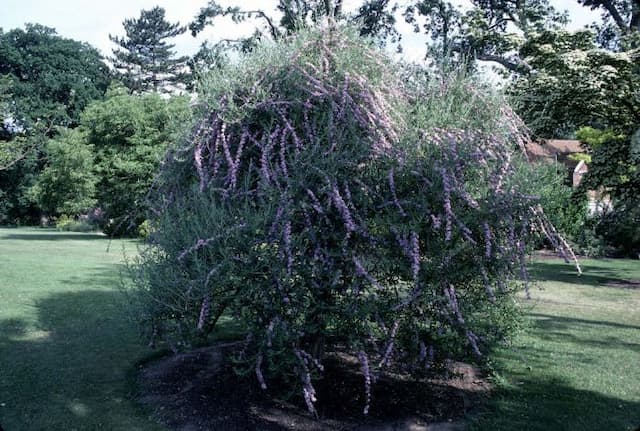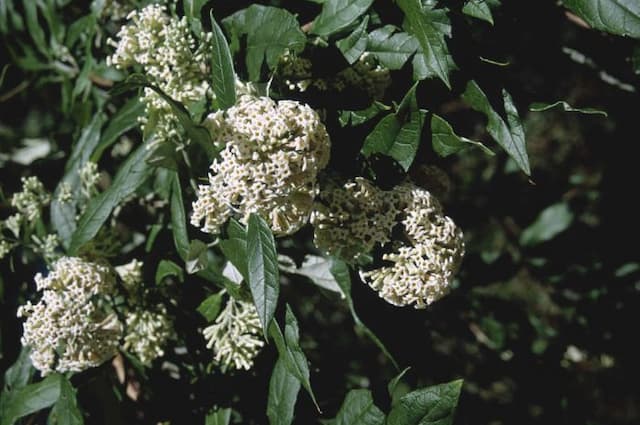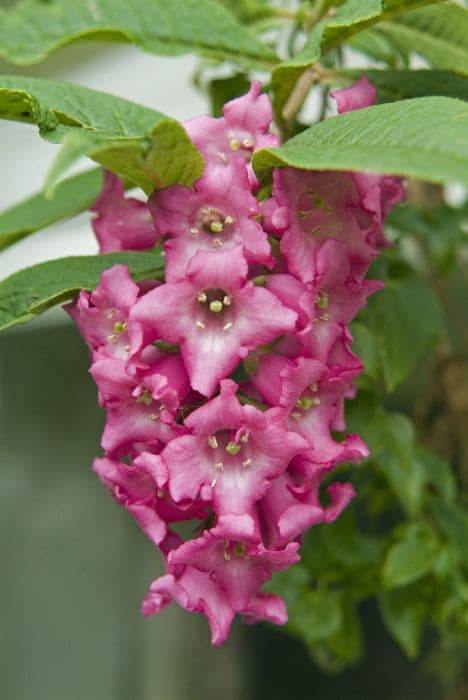Black Mullein Verbascum nigrum

ABOUT
The plant known as Black Mullein features a rosette of basal leaves that are dark green with a slightly hairy texture. As the plant matures, it sends up a sturdy stem adorned with more leaves that grasp the stem in a spiral fashion. These stem leaves are usually elongated and become smaller as they ascend. At the top of the stem, Black Mullein produces a spike of densely packed flowers. Each individual flower is a striking shade of yellow, with five rounded petals that spread outwards from a darker, central stamen cluster, which can sometimes appear to have a purplish tinge. The blossoms tend to face upwards or outwards, presenting a sunny display that can attract various pollinators like bees and butterflies. The overall form of Black Mullein showcases a striking contrast between the lush foliage at the base and the elegant floral spike above, making it a distinctive presence in gardens or wild settings where it grows. The plant's aesthetic is further enhanced by the delicate hairs that cover the leaves and stem, which can give them a silvery or soft, felt-like appearance under the right lighting conditions.
About this plant
 Names
NamesFamily
Scrophulariaceae
Synonyms
Black Mullein, Dark Mullein, Black-rooted Mullein
Common names
Celsia arvensis, Celsia vulgaris, Verbascum arvense, Verbascum aureum, Verbascum decurrens, Verbascum densiflorum, Verbascum lychnitis, Verbascum nigrum var. decurrens, Verbascum roripifolium, Verbascum speciosum, Verbascum wiedemannianum.
 Toxicity
ToxicityTo humans
The plant known as Dark Mullein (Verbascum nigrum) is not generally considered toxic to humans. There is no widespread evidence of it causing serious poisoning when touched or ingested. However, it is important to note that while not toxic, eating or handling plants not known to be safe can sometimes cause allergic reactions or skin irritation in sensitive individuals.
To pets
For pets, the Dark Mullein (Verbascum nigrum) also does not have a reputation for being toxic. Similar to humans, there is no well-documented evidence suggesting that it causes significant toxicity in pets. Still, it is advisable to prevent pets from consuming any plants not specifically intended for them to avoid potential stomach upset or an unexpected allergic reaction.
 Characteristics
CharacteristicsLife cycle
Biennials
Foliage type
Deciduous
Color of leaves
Green
Flower color
Yellow
Height
2-3 feet (60-90 cm)
Spread
1-2 feet (30-60 cm)
Plant type
Herb
Hardiness zones
5
Native area
Europe
Benefits
 General Benefits
General Benefits- Attracts pollinators: Verbascum nigrum, or Dark Mullein, is known for its ability to attract bees and other pollinators to the garden, which is vital for the pollination of many plants and food crops.
- Ornamental value: With its tall spikes of yellow flowers, Dark Mullein is a striking plant that adds height and visual interest to garden borders, beds, and wildflower gardens.
- Drought tolerance: Once established, Dark Mullein is quite drought-tolerant, making it suitable for xeriscaping and gardens in arid environments.
- Low maintenance: It requires minimal care once established, making it an easy plant to grow for gardeners of all skill levels.
- Wildlife habitat: The plant can provide shelter and food for insects, which in turn can benefit birds and other wildlife in the garden.
- Soil improvement: As Dark Mullein grows, its root system can help to break up compacted soil, improving soil structure and fertility over time.
- Erosion control: The plant's root system can also help stabilize soil on slopes and banks, thus preventing soil erosion.
 Medical Properties
Medical Properties- Anti-inflammatory: Verbascum nigrum has been used to reduce inflammation, particularly in the respiratory tract.
- Expectorant: It may help with the expulsion of phlegm from the airways.
- Diuretic: This plant has been said to increase urine production, possibly aiding in the detoxification of the body.
- Antibacterial: Components of Verbascum nigrum may possess antibacterial properties.
- Emollient: The plant has a soothing effect on the skin and mucous membranes.
- Astringent: It can be used topically for its astringent effects, which may help in tightening the skin and other tissues.
- Demulcent: The mucilage present in the plant can have a soothing effect on irritated tissues, particularly within the throat and digestive system.
 Air-purifying Qualities
Air-purifying QualitiesThis plant is not specifically known for air purifying qualities.
 Other Uses
Other Uses- Verbascum nigrum, commonly known as Black Mullein, can serve as a natural dye, providing colors ranging from yellow to green when used in textile dyeing processes.
- The plant has been used to create an infusion for a hair rinse, thought to darken and strengthen hair.
- The soft leaves of Black Mullein can be employed as a natural insulating material or as padding in shoes and clothing for warmth.
- With its tall stalks and attractive flowers, it is often used as an ornamental plant to enhance the aesthetic of gardens and landscapes.
- Black Mullein is sometimes planted to attract beneficial insects such as bees and butterflies to gardens for pollination.
- The leaves can be used as a natural tinder for starting fires due to their flammability when dry.
- It can be a component in companion planting, possibly providing benefits to certain vegetables by deterring pests when planted nearby.
- In historical contexts, the stem of Black Mullein has been utilized as a makeshift torch when dipped in tallow or another flammable substance.
- The flowers are occasionally used in the production of natural soaps and candles, contributing to their scent and color.
- The dense foliage of Black Mullein provides shelter and habitat for small wildlife, particularly in meadow or prairie environments.
Interesting Facts
 Feng Shui
Feng ShuiThe Black Mullein is not used in Feng Shui practice.
 Zodiac Sign Compitability
Zodiac Sign CompitabilityThe Black Mullein is not used in astrology practice.
 Plant Symbolism
Plant Symbolism- Healing - Verbascum nigrum, commonly known as Dark Mullein, has been used in traditional medicine to treat various ailments, symbolizing physical and spiritual healing.
- Protection - The herb is believed to ward off evil spirits and bad luck, representing a symbol of safeguarding and protection.
- Consolation - With its soft, furry leaves and tall flowering stalks, Dark Mullein can symbolize comfort and consolation to those in distress.
- Loneliness - The single stalk reaching upwards is sometimes seen as a symbol of isolation or loneliness.
- Health - Due to its medicinal properties, Dark Mullein is often associated with good health and well-being.
 Water
WaterBlack Mullein should be watered deeply but infrequently to mimic its natural drought-prone habitat. It does best with a deep soak when the top inch of soil becomes dry. During the growing season, this might mean watering with approximately 1 gallon per plant every 7 to 10 days, depending on climate and soil drainage. In cooler weather or rainy seasons, reduce the frequency to prevent overwatering. It's essential to avoid soggy conditions, as Black Mullein is susceptible to root rot.
 Light
LightBlack Mullein thrives in full sun, making it ideal for a spot that receives at least 6 hours of direct sunlight per day. The plant prefers locations that get bright, uninterrupted light, as this promotes the best growth and flowering. Partial shade is tolerable but may result in fewer flowers and a leggier form.
 Temperature
TemperatureBlack Mullein does well in a wide range of temperatures, but it prefers the ranges between 60°F and 80°F for optimal growth. It can survive minimum temperatures down to 20°F, making it suitable for cooler climates. The plant is quite hardy and can withstand a light frost, but for continuous healthy growth, maintaining temperatures above freezing is recommended.
 Pruning
PruningPruning Black Mullein is mostly done to remove spent flower spikes and encourage a second bloom. Cut the flower stalks back to the base of the plant after the first flush of blooms has faded, usually in mid to late summer. Pruning can also include thinning out any crowded stems to improve air circulation. The best time for significant pruning is in the early spring or after flowering.
 Cleaning
CleaningAs needed
 Soil
SoilBlack Mullein thrives best in a well-drained, sandy or loamy soil with a pH range of 6.0 to 8.0. A mixture of two parts sand or perlite, one part garden soil, and one part compost or well-rotted manure will create an ideal environment for its growth.
 Repotting
RepottingBlack Mullein typically does not require frequent repotting as it is a biennial plant. Repot the plant every 2 to 3 years to refresh the soil or when it has outgrown its current pot.
 Humidity & Misting
Humidity & MistingBlack Mullein is tolerant of a wide range of humidity levels and does not have specific humidity requirements, making it well-adapted to average outdoor conditions.
 Suitable locations
Suitable locationsIndoor
Ensure full sun and well-draining soil for Black Mullein indoors.
Outdoor
Plant Black Mullein in full sun and well-drained soil.
Hardiness zone
5-9 USDA
 Life cycle
Life cycleBlack Mullein (Verbascum nigrum) is a biennial plant, which means its life cycle is completed in two years. In the first year, it grows as a rosette of basal leaves close to the ground, focusing on vegetative growth and storing energy in its root system. In the second year, the plant elongates its stem to produce a flowering stalk that can reach up to 2 meters in height, and it develops yellow flowers with purple-studded stamens from June to September in its native habitat. After the flowering period, the plant sets seeds that are dispersed by wind or other means, thereby completing the reproductive phase of its life cycle. Once seed dispersal is finished, the parent plant typically dies, completing its lifecycle. The seeds that have been dispersed may germinate when conditions are favorable, beginning a new generation.
 Propogation
PropogationPropogation time
Spring to summer
The most popular method of propagation for Verbascum nigrum, commonly known as Black Mullein, is through seed sowing. Seeds can be directly sown into the ground in either early spring or during fall. Prepare a well-draining soil bed in a sunny location and sprinkle the seeds on the surface, pressing them lightly into the soil, as they need light to germinate. It is important to keep the soil moist until germination, which usually takes about two to three weeks. After the seedlings have developed their first set of true leaves and reached a height of about 2-3 inches (5-7.5 cm), they can be thinned out or transplanted to their final growing positions, ensuring they are spaced around 12 inches (30 cm) apart to accommodate for their growth.


![Butterfly bush [Berries and Cream]](/_next/image?url=https%3A%2F%2Fplants-admin.emdemapps.com%2Fimages%2Fplants%2F%2Fimages%2F604b650f667be.png&w=640&q=75)





